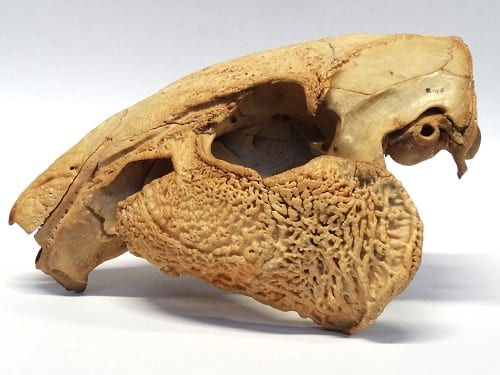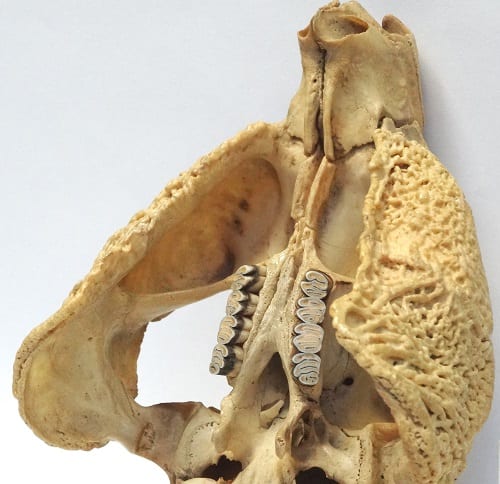Specimen of the Week 211: A Cheeky Chappie – The Lowland Paca
By ucwepwv, on 26 October 2015
Hi, I’m Paolo and this is my first blog post as Curator of the Grant Museum of Zoology, picking up the reins from Mark Carnall. I’ve chosen this specimen of the week based simply on the fact that it has very interesting cheeks – or ‘zygomatic plates’ if you speak zoologese.
This gnarly-cheeked Specimen of the Week is…
**a lowland paca, Cuniculus paca**
which is a large South American rodent in the same group as agoutis and capybaras. When I first saw these rough cheeks I thought that their rugose texture may have been due to a pathological condition of the masseters, which are the chewing muscles that connect to the lower jaw from the cheekbone.
The other paca skull specimens in the same drawer had much smoother cheeks, but they were also much smaller, which raised the possibility that the texture in the cheeks might also be related to age or possibly sexual dimorphism. So I did some research, where I mainly discovered that pacas are a bit weird, and here’s why:
Pacas have amplifiers built into their faces
Lots of animals make noise – it’s a useful way of communicating, especially in forest habitats where it’s hard to see. Some species, like whooper swans and Guatemalan howler monkeys, have evolved special bony structures to help amplify their call, allowing it to be loud enough to hear over long distances. The paca seems to have done the same, by developing a resonating pouch in their zygoma or cheekbone¹:
It doesn’t seem that this adaptation has anything to do with sexual dimorphism, since the males and females are hard to tell apart and they both have the cavities in their cheeks².
Paca babies are scaly
Pacas are precocious, born ready for the world with their eyes open and sharp little teeth already emerged. This probably wouldn’t be much fun for mum at feeding time, but at least pacas normally only have one young at a time. These lone offspring look like small versions of the adults in most ways, but they have polygonal horny scales all over their skin, for reasons unknown² – although one could speculate that they provide some protection from unpleasant showers (see below).
Pacas frisky-hop
Frisky-hopping is basically where an animal does excited little jumps, spins and dashes. Apparently this is also quite common among the paca’s close relatives and is usually triggered by interesting smells². This behaviour is most common in the males, especially when they’re in the mood for love. The females do it too, but usually when they’ve been peed on³, which leads me to…
Paca sex is weird
Any sex that involves urine is going to attract some dubious looks, but the paca male doesn’t seem to mind. He woos his mate by trying to pee on her. Perhaps unsurprisingly she does her best to dodge or attack him, but when he eventually manages to hit his target a few times he apparently wins her heart. That’s when his ‘profusely armoured’, spiky penis with serrated plates gets put to use for a (mercifully) short copulation³. Once the scaly baby paca is born the male gets weird again and pees all over both the mother and their offspring, for no obvious reason², since they don’t seem to form a strong family bond – although given the male’s predilections for peeing on everyone, I can’t say I’m that surprised.

[UPDATE 29/10/2015 IMAGE ADDED – A group of pacas feeding. Cuniculus paca. © Marco Hernández . CC BY-SA 3.0]
References
¹Howell, A.B. 1940. Cheek pouches of the paca. Journal of Mammalogy, 21:361
²Pérez, E. 1992. Agouti paca. Mammalian Species, 404:1-7
³Freiheit, C. 1966. Courtship activity of the paca. Journal of Mammalogy, 46:707
Paolo Viscardi is the Curator of the Grant Museum of Zoology
2 Responses to “Specimen of the Week 211: A Cheeky Chappie – The Lowland Paca”
- 1
-
2
Rhea wrote on 30 October 2015:
What a wonderful first blog, full of humor and interesting facts. I appreciate your professional use of citations, too. Thank you for this article and I’m looking forward to more.
 Close
Close




[…] Oh, and if you like skulls, you might be interested in my first Specimen of the Week on the Grant Museum blog. […]